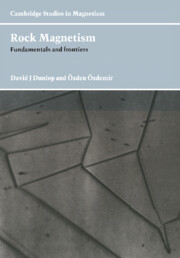Book contents
- Frontmatter
- Contents
- Preface
- Chapter 1 Magnetism in nature
- Chapter 2 Fundamentals of magnetism
- Chapter 3 Terrestrial magnetic minerals
- Chapter 4 Magnetostatic fields and energies
- Chapter 5 Elementary domain structures and hysteresis
- Chapter 6 Domain observations
- Chapter 7 Micromagnetic calculations
- Chapter 8 Single-domain thermoremanent magnetization
- Chapter 9 Multidomain thermoremanent magnetization
- Chapter 10 Viscous and thermoviscous magnetization
- Chapter 11 Isothermal magnetization and demagnetization
- Chapter 12 Pseudo-single-domain remanence
- Chapter 13 Crystallization remanent magnetization
- Chapter 14 Magnetism of igneous rocks and baked materials
- Chapter 15 Magnetism of sediments and sedimentary rocks
- Chapter 16 Magnetism of metamorphic rocks
- Chapter 17 Magnetism of extraterrestrial rocks
- References
- Index
Chapter 2 - Fundamentals of magnetism
Published online by Cambridge University Press: 06 July 2010
- Frontmatter
- Contents
- Preface
- Chapter 1 Magnetism in nature
- Chapter 2 Fundamentals of magnetism
- Chapter 3 Terrestrial magnetic minerals
- Chapter 4 Magnetostatic fields and energies
- Chapter 5 Elementary domain structures and hysteresis
- Chapter 6 Domain observations
- Chapter 7 Micromagnetic calculations
- Chapter 8 Single-domain thermoremanent magnetization
- Chapter 9 Multidomain thermoremanent magnetization
- Chapter 10 Viscous and thermoviscous magnetization
- Chapter 11 Isothermal magnetization and demagnetization
- Chapter 12 Pseudo-single-domain remanence
- Chapter 13 Crystallization remanent magnetization
- Chapter 14 Magnetism of igneous rocks and baked materials
- Chapter 15 Magnetism of sediments and sedimentary rocks
- Chapter 16 Magnetism of metamorphic rocks
- Chapter 17 Magnetism of extraterrestrial rocks
- References
- Index
Summary
Introduction
There are two views of how magnetism originates: microscopic current loops and magnetic dipoles. The latter view is actually the older and is the basis of magnetostatics, the analog of electrostatics. It was discredited when it was demonstrated that magnetic dipoles cannot be separated into isolated + and − magnetic charges (‘monopoles’). Yet the criticism is hardly damning. The component charges of electric dipoles (nuclei and electron clouds, respectively, expressing the polarization of atoms by an electric field) cannot readily be isolated either. Admittedly there is no analog of the free or conduction electron in magnetism, but in many ways magnetically polarized or polarizable materials are close analogs of electrically polarizable materials (dielectrics) and we shall make considerable use of this analogy. Ultimately neither current loops nor charge pairs can explain ferromagnetism. Ferromagnetic moments arise from a non-classical phenomenon, electron spin (§2.3).
A current loop or a dipole produces a magnetic field H or B. What is this magnetic field? H and B are defined not by their cause but by their effect, the forces they exert on physical objects. A magnetic field exerts a torque on a compass needle or pivoted bar magnet (macroscopic dipoles) tending to align their axes with H or B; this is the magnetostatic definition. A magnetic field also exerts a Lorentz force on a moving charged particle, either in free space or when channeled through a conductor as current I, at right angles to both the field and the particle velocity or the current flow; this is the electrodynamic definition.
- Type
- Chapter
- Information
- Rock MagnetismFundamentals and Frontiers, pp. 16 - 44Publisher: Cambridge University PressPrint publication year: 1997
- 3
- Cited by



